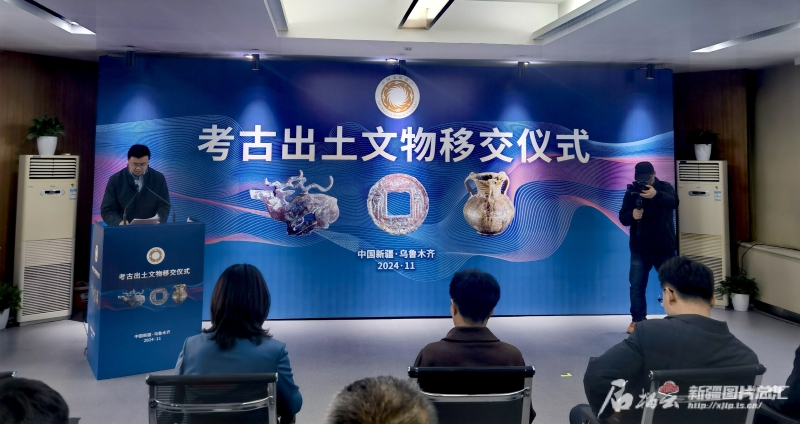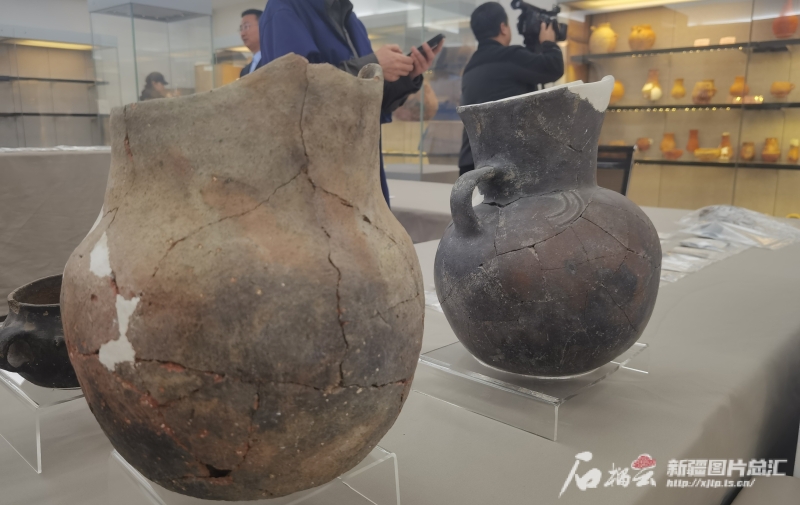Shiliuyun-Xinjiang Daily (Reporter Yin Lu) news: On November 12, 2024, a handover ceremony took place at the Xinjiang Institute of Cultural Relics and Archaeology in northwest China’s Xinjiang Uygur Autonomous Region. During this ceremony, 3,175 cultural relics unearthed from 12 archaeological excavation projects in Xinjiang were officially transferred. This handover marks the largest quantity and most diverse range of cultural relics ever transferred in the region. This event signifies an important step toward normalizing the process of handing over cultural relics discovered in Xinjiang.

Photo shows the handover ceremony at the Institute of Cultural Relics and Archaeology in northwest China’s Xinjiang Uygur Autonomous Region. (Photo by Shiliuyun-Xinjiang Daily/Yin Lu)
Cultural relics recently handed over to museums in eight prefectures and cities of Xinjiang originated from archaeological projects conducted by the Xinjiang Institute of Cultural Relics and Archaeology. These projects encompass notable sites, including the cemetery on Youyi Road in Kuqa City, the ruins along the railway between Kuqa and the Ehuobulake, the Saensa cemetery in Urumqi City, and the Jirentaigoukou site in Nilka County.
These relics date from the Bronze Age through the Song and Yuan Dynasties and encompass a variety of materials, including stone, pottery, bone, wood, copper, gold, and glass. Among the items are production and daily living tools, such as stone millstones, stone mortars, copper knives, spinning wheels, harnesses, and pottery pots. There are also bronze mirrors, coins, weapons like short swords and arrowheads, as well as ornaments such as necklaces, earrings, and belts. The transfer of these cultural relics has significantly increased both the variety and quantity of items collected by museums in Xinjiang. This enhancement plays a vital role in improving the service capacity of these museums and in fulfilling the cultural needs of people from all ethnic groups.
The cultural relics discovered at the cemetery on Youyi Road in Kuqa City represent the largest collection of relics from this archaeological project. Unearthed in 2007, this cemetery was recognized as one of the top ten new archaeological discoveries in China that year. From 2021 to 2022, the Xinjiang Institute of Cultural Relics and Archaeology conducted a comprehensive third excavation of the cemetery in support of the construction of the Qiuci Wei and Jin Ancient Tomb Site Museum in Kuqa. This excavation uncovered 562 tombs that date from the Spring and Autumn Period and the Warring States Period to the Ming and Qing Dynasties. The site features the largest area, the highest number of tombs, and the most complex burial relationships of its kind in Kuqa. The upcoming Qiuci Museum in Kuqa will house nearly 1,700 cultural relics collected from the cemetery on Youyi Road in Kuqa City.

Photo shows two cultural relics to be handed over at the Xinjiang Institute of Cultural Relics and Archaeology in northwest China’s Xinjiang Uygur Autonomous Region. (Photo by Shiliuyun-Xinjiang Daily/Yin Lu)
“The recently handed over cultural relics will significantly increase the number of exhibits at the Qiuci Museum in Kuqa and diversify the types of cultural relics on display. This will allow visitors to gain an in-depth understanding of the historical, political, economic, and cultural connections between the Western Regions and the Central Plains, as well as provide evidence of the administration of the Western Regions by central governments throughout history,” said Gao Xianzhi, director of the Culture, Sports, Radio, Television, and Tourism Bureau of Kuqa City.
Li Wenying, director of the Xinjiang Institute of Cultural Relics and Archaeology, introduced that in recent years, as the only institute qualified for group excavations in Xinjiang, they have actively facilitated the regular transfer of cultural relics and successfully handed over nearly 5,000 cultural relics to 25 museums across Xinjiang to optimize the allocation of cultural relic resources and improve the quality of cultural relics in the exhibition.
"The key to the work with cultural relics is to deeply explore their significance, use them to present historical truths, maximize the benefits of cultural resources, and ensure that people from all ethnic groups can share the results of archaeological excavations," said Li Jun, secretary of the Party leadership group and director of the Cultural Relics Bureau of Xinjiang Uygur Autonomous Region. He added that in the future, they will continue to coordinate various archaeological excavation projects and promote cooperation with museums in Xinjiang. The goal is to ensure that research, protection, and display efforts work together to preserve, inherit, and showcase the remarkable achievements of Chinese civilization.
(A written permission shall be obtained for reprinting, excerpting, copying and mirroring of the contents published on this website. Unauthorized aforementioned act shall be deemed an infringement, of which the actor shall be held accountable under the law.)









